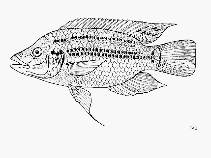http://www.fishbase.org/Summary/speciesSummary.php?genusname=Oreochromis&speciesname=korogwe ---> http://192.134.151.83/Summary/speciesSummary.php?genusname=Oreochromis&speciesname=korogwe
http://192.134.151.83/Summary/speciesSummary.php?genusname=Oreochromis&speciesname=korogwe ---> https://fishbase.mnhn.fr/Summary/speciesSummary.php?genusname=Oreochromis&speciesname=korogwe
https://fishbase.mnhn.fr/Summary/speciesSummary.php?genusname=Oreochromis&speciesname=korogwe ---> https://fishbase.mnhn.fr/summary/Oreochromis-korogwe.html
Oreochromis korogwe, Korogwe tilapia : aquaculture

You can
sponsor
this page
Common name (e.g. trout)
Genus + Species (e.g. Gadus morhua)
-

-
About this page
-
Languages
-
User feedbacks
-
Citation
-
Uploads
-
Related species
-


 Korogwe tilapia
Upload your
photos
and
videos
Korogwe tilapia
Upload your
photos
and
videos
Pictures
|
Google image
 Oreochromis korogwe
Oreochromis korogwe
Picture by
FAO
Teleostei (teleosts) >
Cichliformes
(Cichlids, convict blennies) >
Cichlidae
(Cichlids) > Pseudocrenilabrinae
Etymology:
Oreochromis:
Latin, aurum = gold + Greek, chromis = a fish, perhaps a perch (Ref.
45335
)
.
Environment: milieu / climate zone / depth range / distribution range
Ecology
Freshwater; brackish; benthopelagic. Tropical
Africa: Lower part of Pangani River and neighbouring Zigi River in Tazania and Kenya (Ref.
2
,
52331
,
118630
). Introduced in Mlingano dam, south of Pangani River, and probably other dams in coastal zone of Tanzania (Ref.
2
,
54836
). Also in Lake Rutamba, Lake Nambawala and Lake Mitupa near Lindi in southeast Tanzania (Ref.
118630
,
118638
).
Size / Weight / Age
Maturity: L
m
?
range ? - ? cm
Max length : 16.1 cm SL male/unsexed; (Ref.
52331
)
Dorsal
spines
(total): 16 - 18;
Dorsal
soft rays
(total): 9-11;
Anal
spines
: 3-4;
Anal
soft rays
: 9 - 11;
Vertebrae
: 29 - 30. Diagnosis: A small bodied tilapia (Ref.
118638
). About 50% of individuals have IV anal spines, the modal numbers of vertebrae (29), dorsal rays (27) and gill-rakers (15) are low, and the jaws of breeding males are enlarged (Ref.
2
). Females, subadult males and juveniles with a silver/grey flank colour, light ventral colour, and characteristic melanin pattern of 7-9 broken vertical stripes on the dorsal side giving a spotted appearance; males darker, with a series of white spots/bars on the flanks; ripe males have red margins on dorsal and caudal, with a reddish tinge to the pectoral fins; males from southern populations showed a bluish sheen and less contrasting male colouration (Ref.
118638
). In breeding males the throat and chest are black and broad dark vertical bars are conspicuous on the lower half of the body (Ref.
2
,
4967
,
54096
).
A maternal mouthbrooder (Ref.
118638
). There is evidence of hybridization with native
Oreochromis jipe
in northern Tanzania, and non-native
O. niloticus
in southern Tanzania (Ref.
118638
). Of only minor importance to artisanal fisheries (Ref.
118638
). Maximum standard length of 18 cm (Ref.
4967
) is not confirmed (Ref.
2
, G.F.
Turner pers. comm.
); maximum total length reported as 20.8 cm (Ref.
2
,
118638
).
Life cycle and mating behavior
Maturity
|
Reproduction
|
Spawning
|
Eggs
|
Fecundity
|
Larvae
A maternal mouthbrooder (Ref.
118638
).
Trewavas, E.
, 1983. Tilapiine fishes of the genera
Sarotherodon
,
Oreochromis
and
Danakilia
. British Mus. Nat. Hist., London, UK. 583 p. (Ref.
2
)
IUCN Red List Status (Ref.
130435
)
Least Concern (LC)
; Date assessed:
31 January 2006
CITES
Not Evaluated
Not Evaluated
Threat to humans
Harmless
Human uses
Aquaculture: likely future use
FAO - Publication:
search
|
FishSource
|
More information
Countries
FAO areas
Ecosystems
Occurrences
Introductions
Stocks
Ecology
Diet
Food items
Food consumption
Ration
Common names
Synonyms
Metabolism
Predators
Ecotoxicology
Reproduction
Maturity
Spawning
Spawning aggregation
Fecundity
Eggs
Egg development
Age/Size
Growth
Length-weight
Length-length
Length-frequencies
Morphometrics
Morphology
Larvae
Larval dynamics
Recruitment
Abundance
BRUVS
References
Aquaculture
Aquaculture profile
Strains
Genetics
Electrophoreses
Heritability
Diseases
Processing
Nutrients
Mass conversion
Collaborators
Pictures
Stamps, Coins Misc.
Sounds
Ciguatera
Speed
Swim. type
Gill area
Otoliths
Brains
Vision
Tools
E-book
|
Field guide
|
Length-frequency wizard
|
Life-history tool
|
Point map
|
Classification Tree
|
Catch-MSY
|
Special reports
Check for Aquarium maintenance
|
Check for Species Fact Sheets
|
Check for Aquaculture Fact Sheets
Download XML
Summary page
|
Point data
|
Common names
|
Photos
Internet sources
AFORO (otoliths) |
Aquatic Commons
|
BHL
|
Cloffa
|
BOLDSystems
|
Websites from users
|
Check FishWatcher
|
CISTI
|
Catalog of Fishes
:
genus
,
species
|
DiscoverLife
|
ECOTOX
| FAO - Publication:
search
|
Faunafri
| Fishipedia |
Fishtrace
| GenBank:
genome
,
nucleotide
|
GloBI
|
Google Books
|
Google Scholar
|
Google
| IGFA World Record |
MitoFish
|
Otolith Atlas of Taiwan Fishes
|
PubMed
| Reef Life Survey | Socotra Atlas |
Tree of Life
| Wikipedia:
Go
,
Search
| World Records Freshwater Fishing |
Zoological Record
Estimates based on models
Phylogenetic diversity index (Ref.
82804
): PD
50
= 0.5000 [Uniqueness, from 0.5 = low to 2.0 = high].
Bayesian length-weight: a=0.01905 (0.00827 - 0.04391), b=3.01 (2.82 - 3.20), in cm total length, based on LWR estimates for this (Sub)family-body shape (Ref.
93245
).
Trophic level (Ref.
69278
): 3.2 ±0.40 se; based on food items.
Resilience (Ref.
120179
): High, minimum population doubling time less than 15 months (Preliminary K or Fecundity.).
Fishing Vulnerability (Ref.
59153
): Low vulnerability (10 of 100).
Back to Search
Random Species
Back to Top
Accessed through:
Not available
FishBase mirror site :
localhost
Page last modified by :
mrius-barile
- 20 July 2016
Fatal error
: Uncaught ArgumentCountError: Too few arguments to function checkEcotox(), 1 passed in /var/www/html/summary/speciessummary.php on line 2304 and exactly 3 expected in /var/www/html/includes/speciessummary.lib.php:2579 Stack trace: #0 /var/www/html/summary/speciessummary.php(2304): checkEcotox() #1 {main} thrown in
/var/www/html/includes/speciessummary.lib.php
on line
2579
|